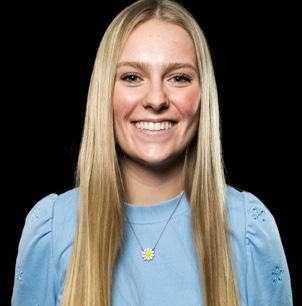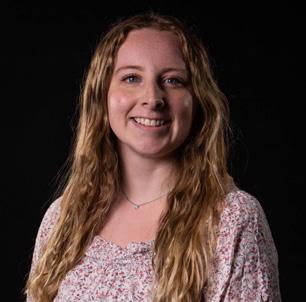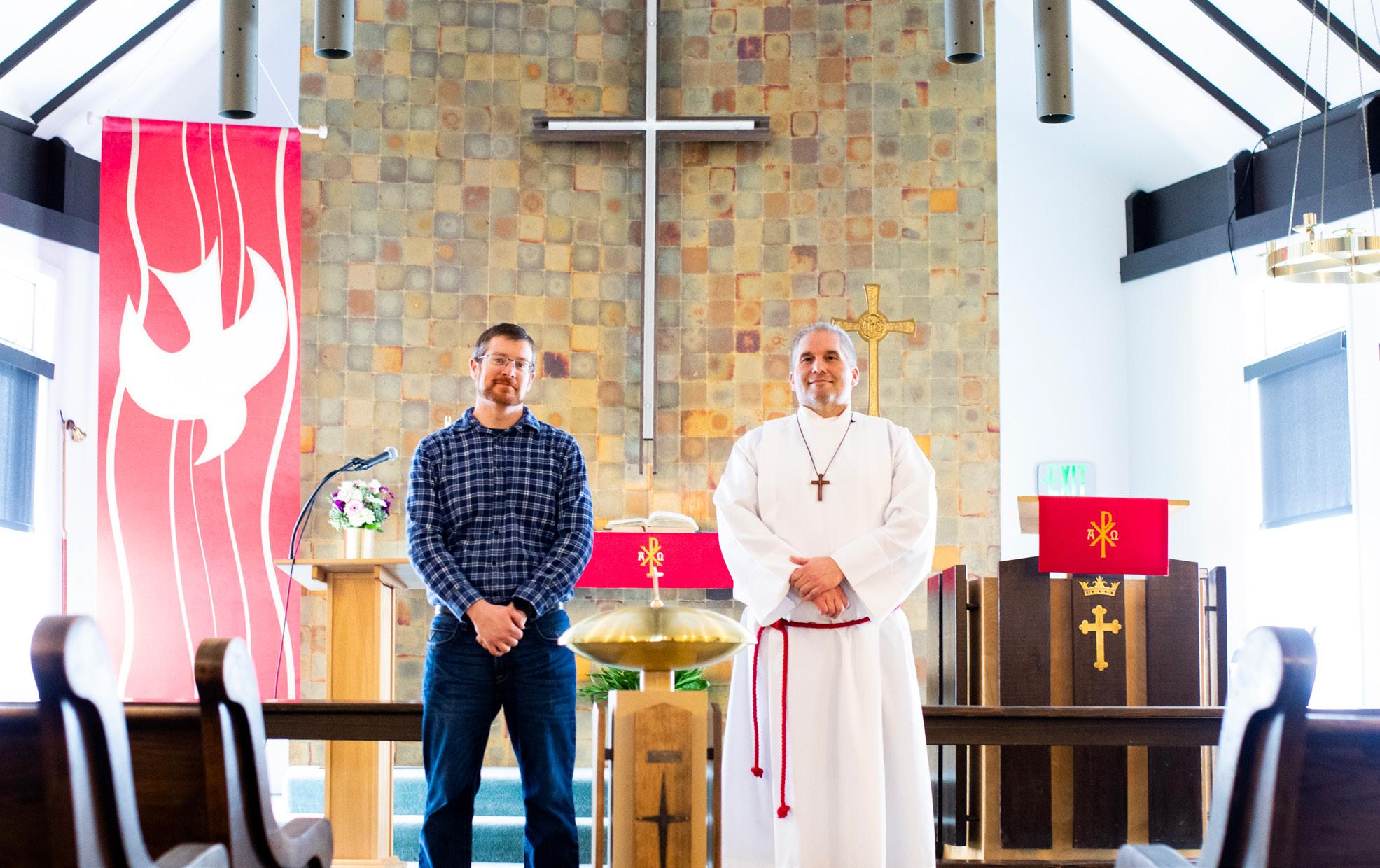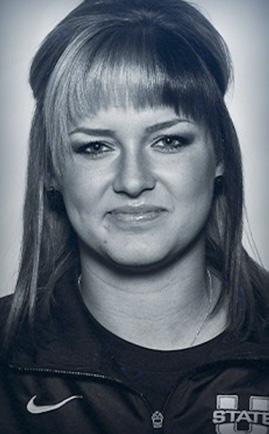

Ellen Eccles Theatre celebrates 100 years
come here as they were traveling around the U.S.,” Nelson said. According to Hassan, the theater showed comedy groups including the Marx Brothers; George Burns and Gracie Allen; and Abbott and Costello.
Today, the administrators of the space are guided by two conflicting goals, according to Hassan: to preserve the space and to maximize its use.
The dedication to preservation is evident in the framework of the theater. Hassan said between 1989 to 1993, the theater was expanded, but the original lobby, theater, stage and fly system has the same footprint.
 By Andie Allen NEWS STAFF REPORTER
By Andie Allen NEWS STAFF REPORTER
The Ellen Eccles Theatre, located at 43 S. Main St., celebrated its 100-year anniversary at the end of March.


Originally called the Capitol Theatre, the doors first opened in March 1923.
“It’s pretty remarkable to still be here after 100 years,” said Wendi Hassan, executive director of the Cache Valley Center for the Arts. “We hope it will last a couple more hundred years.”
To celebrate, the theater put on a three-day series of events.
“The three events represent the three pillars that have kept the theater going,” said Alek Nelson, director of marketing and media for the Cache Valley Center for the Arts.
On the first night, March 29, they honored local talents and arts organizations.
“This featured more than 100 performers from at least 10 groups around the county,” Nelson said.
On the second night, March 30, donations were made by Peter and Mayor Holly Daines for a free showing of “Back to the Future.”
This paid tribute to the theater’s movie showing days while live performing arts were in jeopardy, according to Nelson.
Finally, on March 31, the last night featured Grammy Award winners Marc Cohn and Shawn Colvin in homage to the theater’s many years as a touring stop.
“Ever since the theater opened, it created a really good circuit, so acts from around the world would
The theater has undergone many changes as the socioeconomic status of the country has changed. According to Hassan, a Vaudeville show cost $1.25 in 1923.

“If you went to a show, and you didn’t have enough cash money, the theater accepted spoons, eggs and produce,” Hassan said. “There was adaptation to whatever was going on in the world.”
According to the website, tickets for the show on March 31 ranged from $11 to $55.
Today, the theater is at capacity in what they put on the stage, according to Hassan.
“Our goal is to have more people interact with what is already being done,” she said.
The greater the number of audience members, the more the theater can help the companies using the space stay strong. Full audiences will help attract higher profile shows and allow the theater to continue to be a good partner to the other venues in the community, according to Hassan.
“It’s a celebration and also a show of gratitude to the community,” Nelson said. “Nothing could happen here without the community.”
Andie Allen is a senior studying English and journalism. Outside of writing, Andie loves the sun, reading and wathing her to-beread list grow.
— Andie.Allen@usu.edu

USU students, faculty respond to new social media restriction laws
 By Jenny Carpenter
NEWS STAFF REPORTER
By Jenny Carpenter
NEWS STAFF REPORTER
Gov. Spencer J. Cox signed two bills into law on March 23 — both of which will provide several social media restrictions starting March 1, 2024.
Utah is the first state in the nation to provide such restrictions.
SB152 sponsored by Sen. Mike McKell, R-Spanish Fork, will provide restrictions that involve age verification and permission from parents before minor users can operate any social media accounts.
It also provides a “bedtime” restriction prohibiting minors from using social media between 10:30 p.m. and 6:30 a.m., unless their parents change the settings.
Hailey Johnson, a psychology major at Utah State University, expressed her conflicting feelings.
“I think it’s good because social media is really bad for children and teenagers’ mental health. But at the same time — it kind of seems a little fascist, not going to lie,” Johnson said.
It’s not just the time and age restrictions that have raised concerns from students and social media companies.
SB152 prohibits companies from collecting certain information from minors — and HB311, sponsored by Rep. Jordan Teuscher, R-South Jordan, prohibits social media companies from providing any “design or feature” that will addict minors to their platform.

According to HB311, if these platforms violate this law by providing the design or features, they could be liable for civil fines up to $250,000.
“This is something that is killing our kids. It’s the addictive qualities of social media that are intentionally being placed by these companies to get our kids addict-
ed, and they know it’s harming them,” Cox said at a conference on March 16.
NetChoice, a company representing Amazon, Google and other Meta platforms, expressed concerns that the two new laws would violate the First Amendment. On March 21, the company opened a litigation center.
Cox, however, said he is “not going to back down from a potential legal challenge when these companies are killing our kids.”
Johnson disagreed with the legislation.
“It’s really up to the parents. It really shouldn’t be a state thing where they put regulations; I think it should just be a household-by-household kind of thing,” Johnson said.
Matthew LaPlante, a USU journalism and communications professor, expressed his worries that the law could create several problems, including the need for parents to hand over IDs and home addresses to prove their family resides in Utah.
“It is troublesome in the way that (the legislation) will be carried out because we don’t have a plan for carrying it out. And that includes, troublingly, who is going to be the custodian of these precious records,” LaPlante said.
Larry Magid, the CEO of nonprofit organization Connect Safety, even argued in an opinion piece that SB152 could create compromises in data privacy.
“SB152 would require companies to keep a ‘record of any submissions provided under the requirements,’ which means there would not only be databases of all social media users, but also of users under 18, which could be hacked by criminals or foreign governments seeking information on Utah children and adults,” Magid said.
LaPlante expressed the concern that the legislation won’t be effective in preventing
social media use among minors.
“If students, young people, do not get their parents’ permission, do we really think that they’re going to be avoiding social media?” LaPlante said. “No, they are going to be doing social media now against their parents’ permission, which means even more secretively than they are now — that’s not healthy.”
Teuscher said he hopes the rest of the nation will follow Utah’s lead with the social media restrictions. LaPlante, on the other hand, raised skepticism.
“In this case, I do believe it may be a little while before other states follow suit, particularly if social media companies — as they are almost guaranteed to do — do indeed file suit,” LaPlante said. “Other states are going to let Utah bear the brunt of that. I think we may be leading out a little further than we want to right now, but that’s what leadership requires.”
Jenny Carpenter is a junior studying journalism, Chinese and English. In her spare time, she loves writing novels, reading novels and watching Netflix.
— Jenny.Carpenter@usu.edu

New USU master’s program first of its kind nationwide
By Kate Stewart NEWS STAFF REPORTERThe Center for Anticipatory Intelligence at Utah State University prepares students to respond to emerging security issues.

According to their website, “Anticipatory Intelligence is a multidomain approach to anticipating threats and opportunities emerging from the world’s increasingly complex security environment.”

Students can receive an undergraduate minor, graduate major, or master’s degree in anticipatory intelligence through the CAI program at USU.
Jeannie Johnson, founding director of CAI, has been at Utah State for 23 years. Prior to her time at USU, she worked for the CIA.
Johnson said they began creating the CAI program six years ago. They have developed an interdisciplinary system of education for their program.
“The idea was because the problems we face, the challenges we face — specifically the security challenges we face — because they are complex and intertwined, then our education needs to match the problems and right now, as you know, higher education is really siloed and separate,” Johnson said.
Wanting to overcome this separation of education, Johnson recruited partners from various colleges across the university.
“We have partners in engineering, in the school of business, in the school of agriculture, and wonderful — absolutely wonderful — collaborators who came together,” Johnson said.
She said these partners could see the vision of the interdisciplinary idea and the value of this problem solving approach.
In addition to joining forces with partners at USU, the CAI has established various formal agreements with other universities and institutions.
“We have eight formal industry partners, which you can find on our website,” Johnson said. “We work hand in hand with those industry partners to create internships and opportunities and career paths for our students.”
She said CAI has a fantastic placement rate for their students, with students landing in “terrific programs” all across the country.
According to Johnson, having anticipatory intelligence on your resume gives you a platform to talk about a really unusual and desired education during interviews.
She said many of her students reported receiving this education was their key to success.
The master’s of anticipatory intelligence degree is the first program of its kind in the nation.
“We started with two classes, turned it into a minor, then a graduate certificate, and now a master’s degree,” Johnson said.
The MAI degree was launched this spring, and is struc-
tured to be a two-year program, with 33 credits required.
“We have four different emphasis tracks, and those are all housed in and taught by other colleges at this university,” Johnson said.
The four emphases are international security, cyber and security analytics, biosecurity, and GIS natural resources.
There are no requirements to apply for the MAI program other than having completed a bachelor’s degree.
Johnson said they have a wonderful diversity of students who have joined their program, with differing majors.
“What we would like to emphasize is that we welcome, enthusiastically, all majors. I really need all majors — theater arts majors, folklore majors, soil science majors, all majors,” Johnson said.
She also gave a shout out to all women students who might have “self-eliminated from applying because they think this program is tough.”
“It is tough, and they can do it,” Johnson said. “Ladies, step up. You can do this, and we need you.”
She expressed how important female voices are in the industry.
“We need both sides of the gender — all sides of the gender equation — to be involved,” Johnson said.
Johnson said some students might perceive the program to be very tech-oriented, but that is a misunderstanding.
“It isn’t, it’s problem-oriented. So what we are fundamentally concerned with is the well-being of communities,” Johnson said.
Johnson said this misunderstanding means they have attracted STEM students, but she wants students without STEM backgrounds to recognize they are a valuable and
an essential part of the program as well.
Johnson said right now, the field of anticipatory intelligence is an aspiration for the intelligence community.
“When we say this is an aspiration of the intelligence community, anyone who is working on thinking ahead about what challenges — specifically security challenges — their company, or their community, or their nation may face, they need to know how to do it, and no one has yet developed how to do this,” Johnson said.
Johnson said their challenge is to continue drawing together the brightest minds to think about how they can do a better job of anticipating future challenges that may threaten the security of communities.
“We need people who are really well versed in relationships, in bridge building, in building strong teams of problem solvers,” Johnson said.
The application window for the MAI program remains open. Johnson invites any students who are interested to apply.
Kate Stewart is a junior studying journalism and marketing. Kate is from the Portland, Oregon area and loves all things outdoors, thrifting, family and friends.
 — Kate.Stewart@usu.edu
— Kate.Stewart@usu.edu
Column: An Aggie in the Amazon

While on the tributary we saw many beautiful birds. One of my favorites is known locally as Mamá Vieja because of its loud whining calls. Known internationally as the black-collared hawk, the bird is bigger than an eagle and majestic in flight.
William knew the name and could imitate the call of every animal. He later informed me he studies biology books to maintain his knowledge and recently guided a tour for National Geographic. I felt safe in the wilderness thanks to his competence.
When we stepped off the boat into the jungle, he said, “One rule: don’t touch anything. Insects that bite and sting are everywhere.”
We hiked to a nearby village from the tributary and ate a lunch of pirarucu, a freshwater fish that grows over 10 feet long. The food was served with fried plantain and rice.
Every year the jungles of the Amazon flood, making the forest accessible only by boat. Every structure in the village was built 10-15 feet above the ground to remain above water in the wet season.
Instead, pull him close to your body to remain in control.”
That night after dinner, William gave us unfortunate news.
“Even in my lifetime, I have seen a decrease in the plants and animals present in the jungle. This area exists in a cycle — if one part of that cycle breaks, it can have lasting impacts,” he said.
The next day, we fished for piranhas using pieces of chicken for bait. The piranhas often managed to steal the bait without getting hooked, and William teased us, “I didn’t bring you here to feed the piranhas.”
Despite our fishing inexperience, we caught enough piranhas for lunch. I was startled to see my plate full of sharp, menacing looking teeth after I finished my meal. On our way back from the Amazon, we were once again greeted by pink dolphins playing in the water. Massive barges chugged up and down the river, tossing our tiny boat in the water.
By Tanner Thomsen NEWS STAFF REPORTERWhen I got off the plane in Leticia, Colombia, the first thing I noticed was the pervasive heat. It reminded me of the hot North Carolina summers I experienced as a teenager
Why go to such a hot and humid place? As a child, I remember reading the Magic Treehouse book “Afternoon in the Amazon,” and I was fascinated by the animals and plants Jack and Annie encountered on their fictional journey.
I wanted to experience this infamous jungle for myself.
Leticia, Colombia is in the Tres Fronteras — translated to Three Borders — region at the junction of Brazil and Peru. The Amazon River flows next to the town, providing a much needed source of transportation through the dense jungle.
When I met our tour guide, William, he issued me a pair of rubber boots. I joined the other members of our group and started up stream.
The Amazon River is the largest on Earth. In Leticia, the river is just beginning a long journey to the ocean but already is larger than our Mississippi. As we motored up the river, we saw both gray and pink dolphins splashing in the water.
A unique aspect of my experience in Colombia is meeting many visitors from other parts of the world. This tour was no different. Along with two other Americans, I made friends from Spain, New Zealand, England and Peru.
We started up a small tributary of the Amazon to a native village.
William explained, “The natives promote tourism but not in the way you’d expect. They aren’t going to speak to you beyond a wave and maybe a hello. The welcome you receive is being allowed on this land.”
In the distance, some local children were swimming in the small river. One climbed a tree and did backflips into the water to impress us.
In the Amazon, mosquitos are everywhere. The walls in each structure consist of netting stapled to wooden studs. The insects are gigantic and spread malaria.
William said, “People think the most dangerous killers in the jungle are the jaguar or caiman, but in reality the insects are the true killers — wear repellent.”
We continued our tour deep into the jungle via a trail of wooden planks placed 2-3 feet above the ground. As we trekked, the wood planks were quickly submerged in the murky water. William cut us all walking sticks with his machete, explaining they were for balance and keeping away snakes. Soon the water was up to my shins, even with the elevated planks.
The portion of the jungle we explored was in Peru. William is a Peruvian who travels to different parts of the river doing tours. He speaks Portuguese, Spanish and English. Many native tribes populate the Amazon, some so deep in the jungle they remain untouched by the outside world.
As the water grew deeper, we came across two wooden boats that took us to our destination. At first, William guided the boat with long wooden sticks, so heavy they sank into the water when dropped. Eventually, the water became deep enough to use the motor.
The jungle was thick and difficult to navigate. As our boat exited the jungle canopy, I heard William yell, “Welcome to Piranha Lake!”
I asked if the piranhas prevented us from swimming. I was surprised when he responded, “Piranhas are some of the friendliest animals in these waters. I’d wait until we get back to the river to swim.”
That night we stayed in a large floating house in the middle of the lake. The tour guides took us out that night to catch caiman.

William handed me a caiman longer than my arm and explained, “If he starts to wriggle free, don’t let go.
I have never felt so helpless in the wilderness before visiting the jungle. Simply touching a sapling tree to regain my balance immediately left my hand with four painful ant bites. In the lake, I would look down at the water knowing simply falling in had dangerous implications.
Despite the danger, the Amazon is an incredible place with extreme biodiversity. I was grateful that William had grown up in the jungle and knew how to experience the wilderness safely.
The tour he offers is through Jungle Tours Gamboa and I highly recommend the experience if you ever find yourself in Colombia.
— A02333587@usu.edu
Aggie radio to host two shows this week
By Caitlin Keith LIFESTYLES STAFF REPORTERSeven local bands will be performing on Federal Avenue in Logan on April 15 for Logan City Limits, the end-of-semester music festival hosted by Aggie Radio.

The bands will be split between two different venues down the street from one another, with four bands — including the headliner, Sego — playing at The Annex and the other three bands performing at Whysound.
Along with Sego, the six other bands performing are future.exboyfriend, Guava Tree, Hurtado, Holy Water Buffalo, The What-Nots and Sleep Cult.
The event, which is free and open to the public, will take place from 6-10 p.m. on Saturday evening, with doors opening at 5:30 p.m.
Mayson Garrett, a sophomore at Utah State University majoring in international studies, works as the public relations director for Aggie Radio. Garrett has had a major role in planning the festival, bringing together the bands and booking the venues.
Garrett said Logan City Limits has a “different vibe” than Big Agg Show, which happens at the beginning of fall semester.
“It’s more of a rock music festival in genre than say the Big Agg Show, which is more of a pop music festival,” Garrett said. “It’s a little bit of a different audience and a different vibe, and super fun.”
Aggie Radio station manager Audrey Flood is a junior studying human experience design and interaction. She said Aggie Radio, which is entirely student-run, provides live radio for campus and the community around the university, including programmed music and live shows from DJs.

“Aggie Radio is our on-campus radio station here at USU,” Flood said. “We also have a focus on supporting local music, especially bolstering the local music community here in Utah and Logan.”
Cathy Ives is a public radio consultant who has worked at a variety of stations throughout the country. Ives worked as the general manager for Utah Public Radio from 2006-2010 and played a major role in the founding of Aggie Radio.
When Aggie Radio was first formed, it was an online-only radio station. It became an FM station in 2016. Ives said Aggie Radio came to be thanks to students coming to her at UPR who wanted to be a part of a radio station and to be on the air.
“Putting Aggie Radio on the air was a perfect mix of all of those things, because it did allow the students to take the ball and run with it — they were able to have their
own broadcast system,” Ives said.
Over the years, Aggie Radio has grown and is now able to put on bigger concerts and events such as Logan City Limits and Big Agg Show.
Sego is a band that has worked closely with Aggie Radio in the past and is coming back to headline at Logan City Limits.
“We’re bringing Sego on Saturday, which is going to be so fun,” Flood said. “They were really supportive of Aggie Radio previously when they were getting on their feet, and now they’ve become a lot bigger. I’m really glad to have them back. It’s a beautiful little full circle Aggie Radio moment.”
Another group performing at the event is Holy Water Buffalo, a band from Heber, Utah. Garrett said they have been touring with Sego, which is how they ended up being on the bill for Logan City Limits.
Logan City Limits isn’t the only show Aggie Radio is putting on this weekend. Working alongside USUSA, Aggie Radio is also hosting the End of Year Bash, which is taking place Friday, April 14.
End of Year Bash features five bands: Cinders, The Rubies, Goldmyth, Poolhouse and Basement Waves. These bands play more pop and mainstream music than that of the bands at Logan City Limits, according to Flood. Garrett said people should get excited for Logan City
Limits because it is a big festival event that doesn’t happen very often in Logan.
“It’s going to be a lot of fun, and I think that just because you don’t know an artist and their music doesn’t mean that you can’t come and enjoy it,” Garrett said. “I think it’s going to be a fun time at both End of Year Bash and Logan City Limits. People can just come and have fun and enjoy some music.”
Caitlin Keith is from Utah and is currently a junior studying journalism. Other than writing, she enjoys watching and ranting about tv shows or sports, speaking German and eating snacks.
Sego’s return home for Logan City Limits
By Carlysle Price LIFESTYLES STAFF REPORTEROriginally from Provo, Utah, drummer
ThomasCarroll and singer/guitar player
Spencer Petersen now live and create in Los Angeles.
The two musicians have been playing together for about seven years, according to Petersen. Their band, Sego, has been together since 2014.
Carroll grew up with a dad who was a drummer, and naturally gravitated towards those footsteps. The two friends joked it was in Carroll’s lineage, as his grandfather, uncles and brothers all drummed as well.
Petersen grew up doing orchestra before eventually joining the band scene.
“You get seduced by band world and scenes, and it kind of takes over,” Petersen said on a phone call.
In Utah, Petersen and Carroll would go to Velour Live Music Gallery in Provo to watch other bands, then go home and work on their own skills. Inspired by their favorite artists, they heard new sounds from musicians around them.
“On a local level when people are accessible, when you get immersed in that from a band perspective, you quickly broaden your influences, and your inspirations, and thus it makes your own sound so much more distinct,” Petersen said.



According to Petersen, a friendly competition happened between local bands who pushed each other to be better — leading to personal evolutions.
After moving to LA, the two friends were able to get into the city’s music scene and meet keyboardist/guitarist Kathleen Frewin and bassist Alyssa Davey.


The four rehearse in a warehouse they share with a couple of other bands and create music they describe as “art-punk.” They create songs based on personal inspirations, and each band member writes when they feel so inclined. Just like moods can change, so can their sound.
“That’s why I call it art-punk. There’s like a refinement and a complexity to it all,” Petersen said. “But there’s also sloppiness and kind of an irreverence to it all. I’ve never felt exactly like a super-pro instrumental-

ist, and so I think the marriage between that kind of grungy, punky technique mixed with more of the refined creates a lot of the sound.”
The group is always creating, and they have a digital graveyard full of lyrics and music that could be called upon for future songs.

“We always kind of keep building ideas and throwing them in the bucket. And then going through and figuring out what works for the next record,” Petersen said.
Just last spring, Sego stopped in Provo in the middle of a tour to record an album they had been working on.



This record is still being released, with the second track dropping on April 14, just a day before Logan City Limits. Titled SURRENDER, the song feels up-beat, though lyrics are a bit more existential. It perfectly matches Petersen’s description of Sego’s music — having complexity with an irreverent flow.

“We feel comfortable kind of experimenting,” Carroll said. “We also want to play at our best, because we do feel like Utah is a home base for us. And it’s where we cultivated and grew up.”
The group is excited to perform for Aggies on their next Utah tour, and look forward to getting some skiing in this late in the year.
You can find Sego on Spotify and on Instagram @ sego.


Aggie Radio’s year-end concert series consists of End of Year Bash and Logan City Limits this Friday and Saturday. Listen to some of the artists playing these shows below!
Neon Me Out Sego

Tree House Cinders

Feeding Me Lies
The Rubies
Molly future.exboyfriend
Not a Need Guava Tree
band Guava Tree to perform at Logan City Limits
By Avery Truman LIFESTYLES STAFF REPORTER
Local band Guava Tree is performing at Logan City Limits Saturday, April 15 at The Annex and Whysound.
Mowgli, lead vocalist and guitarist of Guava Tree, was born in Colombia, which was the inspiration behind the name of the band. He wanted to have a tie to his home country while he lived elsewhere.
“I want to be able to plant my roots in the places that I am,” Mowgli said. “So that’s kind of the idea of Guava Tree, is we want to like, go everywhere and spread our love and plant our roots and let our fruit grow all over the place.”
In his songwriting process, Mowgli writes poetry and guitar compositions before putting them all together. “I just let everybody do exactly what they really want to do for the most part,” Mowgli said. “And then they just kind of jam it and try to like, orchestrate and pitch ideas together.”
Mowgli said up-and-coming musicians should “be a big part of the scene.”

“Go to all of the shows and get to know everybody,” Mowgli said. “Don’t be afraid to walk up to people and shake their hand and be like, ‘Let’s jam.’”
Mowgli said the band’s new song, ‘Out of Your Head,’ is about being a good part of the world and making it a better place.
“My goal with Guava Tree is to raise the vibrations of everyone who hears us,” Mowgli said.
Dan Fields, the percussionist, said the band works together to write some of their songs’ instrumental sections.
“We’ll be in the middle of a jam and something will happen, or we’ll have an idea and share it, then try it out on the spot,” Fields said. “So it definitely like, starts with Mowgli and then kind of expands quite a bit after that.”
Fields said an important part of Guava Tree is keeping the music at the core.
“Keep music at the focus of being a musician,” Fields said. “A lot of times, people who get started out are quick to — you know, they’ll talk about their Instagram and their Spotify and all their pictures and everything before they just like, let themselves be touched by being a musi-
cian or by the music.”
Caleb Hays, the band’s drummer, enjoys creating music in the moment.

“It’s like a constant evolution of music,” Hays said. “Everybody’s just giving each other new ideas or kind of interpreting it differently depending where we’re at with our musical journey.”
According to Hays, joining a band has helped him with trust, communication and to develop as a person.
“I’m the newest addition to the band,” Hays said. “I think music and life are like pretty much the same.”
For new musicians who are trying to get their foot in the door, Hays recommended trying as many options as possible.
“Play with as many different musicians as you can, even if you don’t really understand where they’re coming from, like they play a different style of music,” Hays said. “Trying to blend your influences and trying to create something, even if it’s new or weird to you — I think that’s really beautiful.”
According to Hays, a good way to get into music is by going through the ups and downs of life and accepting everything it has to offer.

“You find out what music is just like, you know, by living life and like being around people,” Hays said. “If you just make that your mission, you will find out what music is and what it means to you.”
Tracen Bradshaw, the band’s bass player, said their setlist is often orchestrated on a show-by-show basis.
“We often like to make our songs lead into each other and kind of write like a continuous sort of motion in our set. It kind of brings the writing process into each show,” Bradshaw said. “Sometimes live, we’re just like, ‘Alright, it’s time to do this instead,’ or you know, completely throw the list out the window or whatever, and I think that’s what makes it a lot of fun.”
Bradshaw said joining Guava Tree and handling what it has become changed his life plan.
“Make a band,” Bradshaw said. “It’s hard to not be self-conscious, but just get out there. It’s so much fun.” Guava Tree’s music can be found on Spotify, YouTube Music, Apple Music and Instagram @guava.tree.
Sitting down with Salt Lake City band Hurtado
An air of comfort and camaraderie surrounded the four members of Hurtado, a band based in Salt Lake City. Introspective responses were juxtaposed with fits of laughter and inside jokes as they talked about their music, upcoming projects and the plan for their performance at Aggie Radio’s spring festival, Logan City Limits, on April 15.
Currently composed of lead singer Sam Hurtado, Simon Palo on bass, Will Washburn on guitar and Simon Griffen on drums, the band was formed in 2021 and has “seen several iterations of the lineup and style of music,” according to Hurtado.
“Hurtado is my band. It’s my project — but I kind of hate when people use the word ‘project’ because I think it’s really dumb,” he said.
The band described their style as a tribute to college radio stations.

“College rock is what we call it. College radio stations, especially in the 1980s, are a lot of what we listen to,” Hurtado said. “No offense, but college radio has not had the influence that it once had because of the internet and streaming services. We call it post-college rock, which makes no sense at all, but it’s like a lot of jangle-pop, new wave influence and indie.”
Hurtado will perform original songs for their set at Logan City Limits. They explained the songwriting process begins with lyrics written by Hurtado that are taken to practice for the rest of the band to experiment with from there.
“I think a lot of the influence and songwriting is just from experiences and how I view stuff and my interpretation of experiences I’ve had,” Hurtado said. “Whether it’s romantically or stuff with my friends. What used to happen and what is beginning to happen again is Simon, Griffen and I will FaceTime when we like songs that we’re working on, and then when we come together, we work on them more.”
They may perform a cover as well.

“On the way here, we talked about Hoobastank and a song called ‘The Reason.’ We might do that if we are brave enough,” Hurtado said.
Their experiences being musicians, rather than listeners or audience members, changed their view of music.
“I can say that all of us listen to large amounts of music. Before I was even in a band, I was listening to music — walking the hallways at school with my earbuds in, being all edgy and sad,” Palo said. “But you know, I started playing in one project that gave me a whole new idea of what I can do and what is inspiring with my playing style. From there, I started playing in two other projects, which
barbie discourse in 2023 is insane. acting like Ken was marketed towards little boys and men are losing representation. No baby. ken was designed to officiate a 7 year old girls barbie wedding or to pad out the forces of the invading army in her war reenactment
really expanded my horizons, and figured out how to work with different spaces and genres and all of that, so it did alter my headspace when it comes to music.”
Being in a band changed the way they feel about music production overall.
“I appreciate the production and the balance. There’s a truism to guitar,” Washburn said. “The hardest part of playing guitar is to play nothing — which is fair, but it’s also boring, and it sucks — so you have to balance doing a lot and doing nothing that creates a nice feeling of space and balance in a song.”
Like Washburn, Hurtado also notices good production.
“I have also appreciated quality production and just songwriting, because that’s what I am first. Before a guitar player and definitely before even a musician, I am a songwriter,” Hurtado said. Hurtado has singles out on streaming services and will be coming out with a new single, “All About You,” and an EP in the fall.
“We’re going to work hard, follow the music, leave it all on the court,” Griffen said.
Leah Call is a junior pursuing her degree in print journalism. In her free time, she loves finding new music to jam to and is always on the lookout for the perfect iced chai tea.

— A02395831@usu.edu


Holy Trinity Lutheran Church binds together during search for new pastor
By Darcy Ritchie MANAGING EDITORThe pastor’s study is on the bottom floor of Holy Trinity Lutheran Church in Logan. Though the lights are off during the Sunday service, the afternoon sun streams in from a large window, illuminating bookshelves, a desk and a few chairs.
In the early 1990s, these shelves were filled with the belongings of Pastor Gene Whitlatch. During that time, books and photos came and went until Whitlatch left for a congregation in Boise.
The shelves were empty for a year before Pastor Robert Weller moved in, and he wrote his sermons at that desk for the next six years before he cleaned out the study.
A year later, Pastor Scott Holder moved in. Eleven years later, he moved out. He’s moved congregations three times since then.
The most recent books on the shelves belonged to Pastor Josh Heimbuck. Though he cleared the office out when he left in 2021, some loose items still remain: a printer, various cords, some empty binders.
But the shelves have been empty since. They were empty when I arrived at Holy Trinity for the first time in February. I’d gotten to the church earlier that morning wearing a new dress and scuffed boots. Standing in the snow, I waited for someone to walk through the door first so I could follow them.
I’d forgotten my pen in the car, so I used the prayer roll pencil to jot down as much as I could about the building. The Christmas tree was still up, all the decorations were green, and around 30 people sat throughout the wooden pews during the service.
I had to pause my furious notetaking for the salutation, during which everyone in the congregation made their way around the room. They each shook my hand.
“Good morning.” “God’s peace.” “God’s peace.” “Good morning.”
One of the members read from the First Epistle to the Corinthians: “For when one says, ‘I follow Paul,’ and another, ‘I follow Apollos,’ are you not being merely human?”
Andrew Schuettpelz explained the verse further in his sermon. The apostle Paul, he said, was writing about divisions in the church at Corinth, where some early Christians had taken to listening to one leader and other believers to another.
“And we thought it was a problem having four elders leading worship service,” he said, receiving scattered laughs from the congregation.
Though he was giving the sermon, Schuettpelz is not the pastor of Holy Trinity. He’s a faithful, friendly spacecraft engineer. Mark Brunson is a guitar-playing, sweater-wearing professor of environment and society who charts out Sunday worship service each week and leads the hymns every other week. Jeremy Edwards works for a power company and gave his first sermon last month. Joseph Pierson is a deputy sheriff currently assigned as a
bailiff, planning to retire and study for the ministry, which is probably why he described the role of the pastor as being like the judge in a courtroom.
These four are the elders who have been filling in while the pastor’s study remains empty.
At the time of my first visit, it had been 15 months since Pastor Heimbuck had left. The church at the base of Old Main Hill has gone without a leader since.
“Every time we have a vacancy, getting a new one is difficult, given our location and demographics,” Pierson said.
Logan is 40 minutes from the interstate and 85 minutes from an airport. A 2014 study reported that less than 1% of adults in Utah are Lutheran. The congregation at Holy Trinity is small, and more members are over 50 than under.

Being old, small, and in the middle of nowhere makes it more difficult for Holy Trinity to get a new pastor, and a shortage of pastors only makes it harder.
“In some sense, we're playing musical chairs with pastors because there's only so many out there,” said Kathy Bayn, a friendly, chatty woman who has been attending Holy Trinity for half a century. “We're vacant, we don't want to be vacant, so we're going to call somebody. Well, that's going to cause a vacancy somewhere else.”
The days of pastors staying in one place, marrying and burying everyone in a community, are over. These vacancies are common, so the elders are well-equipped to
fill in.
Since Pastor Heimbuck left, the four elders have led Sunday worship and kept track of the congregation. They also make up the committee responsible for extending a call to a new pastor.
They make these decisions from a computer screen, four squares on a Zoom call. Brunson described it as a meeting between old friends who are facing a new challenge.
The first question they needed to answer was whether they would extend a call to a pastor in the field or one right out of seminary. A small number of students leaving the seminary makes that path more difficult to begin with, but the elders also agreed that someone who is more seasoned might be more comfortable with their older congregation.
That’s what the elders thought they may have found when a pastor from California reached out to ask if they would consider him for the job.
The elders also had to consider a list of other candidates from the Lutheran Church-Missouri Synod Rocky Mountain district. But when that list was narrowed down to a handful of pastors who were presented to the congregation and voted on (in a meeting that Brunson said wasn’t “heated” so much as “spirited”) the pastor who had reached out was the top choice.
So, they extended the call.
“We thought it was a slam dunk,” Edwards said. But the pastor declined.
Schuettpelz was surprised but didn’t allow himself any other reaction. “It's a call from God, but there is the human aspect of it, too. They have to pick up their families. Maybe they're living near an elderly parent, and at the moment they're feeling called by God to stay there,” he said. “So it's a tough balancing act between God's plan — which we never fully know — and our little human plans.”
And so the process started over.
But the committee couldn’t just go with option B. God was pointing them in the direction of that first pastor.
“We need to put that trust back in God's hands and get a new list of names, and hopefully he leads us to one that will say yes,” Edwards said.
This is also a strategy to avoid conflict since both the pastor and the congregation would know they were the second option.
“You don't want to create a situation where you have these underlying responses that are driven out of sin,” Schuettpelz said. “They're not driven out of love and God's plan for us. So the whole goal is to remove those barriers to create the best possible scenario for a pastor and congregation.”
Pierson will start his seminary classes online this fall, and he hopes to one day be the pastor at Holy Trinity, “however it plays out.” His aspiration is to take over when he is done if there still isn’t a pastor by then — or whenever the next vacancy is. But the program takes four years.
From leading Sunday service to starting seminary classes to going through the call process again, there’s a lot on the elders’ plates. But there’s some things the pastor was responsible for that the elders are not ordained to do, and so anyone with pastoral needs has to be connected with a pastor from another congregation.
Most of the time, it’s younger people who need a pastor, whether for a wedding, baptism or confirmation. Since the demographic at Holy Trinity is older, it hasn’t really been an issue so far.
But for Schuettpelz and his wife, who are expecting a baby in June, it will be. Lutherans practice infant baptism, so if there isn’t a pastor at Holy Trinity by then, they will have to find one to baptize their baby.

“It's something that's sitting around in the back of my head floating there,” Schuettpelz said. “Are we going to have a pastor by then? How will my wife and I handle that?”
Edwards also had to make special arrangements for his son, who is in middle school and ready to go through a two-year confirmation class. Normally, he would meet with the pastor weekly and complete other special projects. Instead, he will attend the class over Zoom with another congregation’s pastor this fall.
The biggest loss is Holy Communion, which the elders are not ordained to perform. Pastor Heimbuck performed it every week but, since he left, a retired pastor visits the congregation once a month to administer the Lord's Supper.

Though it’s common for attendance to dwindle during a vacancy, that hasn’t been the case for Holy Trinity, small as the congregation is.
In towns that aren’t in the middle of nowhere, or
filled with members of the Church of Jesus Christ of Latter-day Saints, as Logan is, people can move to a different congregation that actually has a pastor. Other than Holy Trinity, the closest Lutheran church for people in Cache Valley is 45 minutes away, in Ogden. So, their only option was to come together.
Giving has been consistent, too. Piles of grocery bags and egg cartons to be donated to the Cache Community

Food Pantry cover a table in the basement. Empty baby bottles wait near the entrance to be filled with money for the Center for Pregnancy Choices.
“Some people have stepped up and done even more than when there wasn't a pastor, the elders especially. They've had a lot put on them,” Bayn said. “But others are trying to help them maybe more than they would when the pastor is there, and that's kind of a good thing to do every once in a while to light a fire.”
Other things have fallen through the cracks. The Christmas tree stayed up until February. A handful of us stood outside the church building on a recent week because no one told us services had been canceled for weather. Members don’t have a pastor to share confidential conversations with.
“But,” Bayn said, “we’re not falling apart.”
Actually, Pierson said, the congregation comes closer together during times like these.
“During a vacancy, I think we bind together, and you see a lot of people stepping up out of their comfort zones and doing stuff they normally wouldn't,” he said.
When Pastor Heimbuck left, Schuettpelz said, “there wasn't really a sense of, ‘Oh, no the world was going to end, what are we to do?’ It was ‘OK, folks, we all have strengths and weaknesses. We have our roles in the church. Let's just fulfill them to our best.’”
And the world hasn’t ended. By the second Sunday of March, the Christmas tree was down. Before services began, someone announced that more than $1,000 had been raised by the congregation for a snowblower for a Lutheran outdoors camp. There were still around 30 people sitting in the pews that day.

A retired pastor, David Fischer from Salt Lake City, led worship service. I struggled through unfamiliar hymns, which were accompanied by an organist instead of Brunson’s guitar.
When ushers came through the congregation inviting people to receive Communion, members walked forward and kneeled in a row while the congregation continued to sing. Each received either Communion or a blessing from the pastor. Then, they were dismissed, and another row took their place. Once everyone had their turn, we stood and thanked God.
After a final hymn, Pastor Fischer told us to go in peace as we serve the Lord. We filed downstairs for a potluck lunch, and members chatted amongst themselves while finishing touches were put on the food.
The door to the empty pastor’s study was wide open the whole time.
Tyler Thornton: Life as a collegiate athlete
By Madison Weber SPORTS STAFF REPORTERTyler Thornton is a senior on the Utah State University softball team. As her final season as an Aggie concludes, she reflects on what life is like as a collegiate athlete.


Being a student-athlete may seem glamorous, but it has its difficulties. Balancing sports, school, family and social life is just one challenge Thornton has faced. But in the end, she believes the pros outweigh the cons.
“I think I have felt every single emotion in the book regarding graduating and moving on,” Thornton said. “Softball has been my life for so long. For most of my life, softball has been there.”
Thornton is a utility player for the team, leveraging her skills in various positions on the field. The past two seasons, she earned academic all-Mountain West honors, was named a Mountain West Scholar-Athlete and received the Joe E. and Elma Whitesides Scholar-Athlete Award. These awards were earned because of her ability to balance school and sports.
“Tyler is one of those kids that does everything right on and off the field,” head coach Steve Johnson said. “She’s great. She never gets in trouble. She works her tail off in the weight room and in practice. She leads by example.”
After centerfielder Mazie Macfarlane suffered an injury this season, Thornton embraced the team’s “next man up” mentality and has taken over a lot of Macfarlane’s responsibilities, according to Johnson.
“Given an opportunity and has really grown in that — I mean, she’s hitting great in conference,” Johnson told the Mountain West Network. “It took a little bit as she built up into the season, but again, that everyday experience, she’s stepped up into that role and filled that spot nicely.”
While embracing a bigger role on the field, Thornton has had to keep up her academic devotion.
Thornton said she often has to do homework on the road and coordinate with her professors because of the missed class time.
“I found planning is so important. Everything is just on my phone. It’s all color-coordinated,” Thornton said. “I have to put designated homework time into my phone and have a plan of exactly where I was going to go, and what I was going to do — just planning everything out to make sure I get everything done.”
Angelique Heaton, a close friend of Thornton’s, admires how she manages her time among all her responsibilities. “She really utilizes the mentors in her life. Softball takes a lot of time from school for athletics, so she’s always meeting with T.A.s or professors to catch up,” Heaton said. “Being a kinesiology major, she is very passionate about the body and takes her minor or major injuries as real-life opportunities to learn. She has her athletic physicians teach her exactly what is going on until she understands it.”
Heaton mentioned the struggles she’s seen her friend go through and how she overcomes them.
“She does what it takes to show up. I’ve seen her come back from practices or in tears because it was so hard, but the thing is, she keeps going back because she knows she loves it, and then she’ll get through what she’s struggling
with,” Heaton said.
Gabriella Jimenez, a graduate infielder and catcher on the team, talked about the mental challenges of being a student-athlete and how important it is for the players to support one another.
“Softball specifically, it’s a game of failure. You fail more than you succeed. And I feel like it could take a toll on you. Our coaches and our staff here have given us resources to go to if we needed any kind of help,” Jimenez said. “Last year, we really had like a culture where we knew we could pick each other up if you were struggling. This year we’re trying to build on that and letting others know if you fail, someone’s going to be there to pick you up.”
There are mental challenges student-athletes face throughout their collegiate career. Transitioning from high school sports may be one of the toughest.
“Especially coming to a D-I level, there’s a lot more pressure that’s put on you than in high school. I mean, it’s a smaller team, you have to do your job. It’s very supportive, but you’re kind of just expected to do your job,” Thornton said. “If you don’t do it, the coach isn’t going to be like, ‘OK, let’s get you there.’ You are just kind of expected to. That can be tough mentally.”
Not only are collegiate games played faster, the commitment means something different.
“It’s definitely different because, in high school, it’s more of an activity. It’s just an extra. College is a lot more pressing on your time and mentally and emotionally,” Thornton said. “You’re going to have rough practices, you’re going to have rough days. But the difference in college athletics is every single day for a long period of time, and you really just have to figure out how to get over it faster. Each day is a new day, whereas, in high school, it was not as intense.”
Many students play high school sports, but not everyone
has the opportunity to play at the collegiate level.
“There are roughly 470,000 kids who play high school ball, and there’s about 29,000 that play any level of college, and there’s even fewer that play Division I,” Johnson said.
Johnson has seen players struggle going from being the star player to sitting on the bench.
“Sometimes it’s hard when you’ve been able to do some things very easily, and now those things you’ve got to work a lot harder on,” Johnson said. “The biggest thing for a lot of kids is they feel like they’re failing when they’re really not. They just have to adjust and understand that it’s little adjustments that have to be made, not perfection.”
Thornton said the mental struggles and difficult transition from high school are all worth it if it means she can be an example to others.
“It has meant the absolute world, especially being from Cache Valley. It’s been a hard transition for sure. A lot of growth has taken place. You’re getting to know yourself on your own but then also getting to know yourself in the game,” she said. “To have earned the pressure and the ability to compete and work and have the experiences that I’ve had is such a blessing.”
Being a woman in college athletics means a lot to Thornton. She hopes she can inspire young girls who come to watch their games.
“I have been thinking a lot about how thankful I am to be in women’s athletics at Utah State and how thankful I am to be on the softball team. I’m so thankful for the opportunity I’ve had to show strength and represent the strength of women through sports at a high level,” she said.
Thornton said this life requires hard work, mental toughness, resilience and grit. But she is grateful for the opportunity.
“I’m thankful to be a part of a strong group of women who are all going for the same goal and who are all a part of the same motivating force, which is sports,” she said. “I’m thankful that I can able to be a part of something that’s bigger than myself, and women’s athletics has given me that opportunity to be able to do that and to represent on a big platform.”
It’s hard for Thornton to imagine a life that doesn’t include full-time softball, but she’s looking forward to what’s to come.
“As it’s coming to a close, it’s very bittersweet. I’m excited to kind of move on and start the next chapter of my life, but I will always miss this once it’s gone. It will always have a piece of my heart, Utah State,” she said.
“Everything that encompasses being an athlete is just such a special experience that I’m going to miss so much.”
Madison Weber is a senior studying journalism and international studies. Her favorite things include good food, travel, dogs, and spending time with family.

USU Athletics celebrates Title IX with Hall of Fame weekend


 By Jake Ellis SPORTS EDITOR
By Jake Ellis SPORTS EDITOR
To cap off Utah State Athletics’ recognition of the 50th anniversary of Title IX, USU will feature a “Celebration of Women In Sport” gala and the annual Hall of Fame induction ceremony as part of the 2023 Hall of Fame Weekend.
“It's an important weekend for us to make sure we're recognizing and educating folks on women's athletics,” said Ryan McLane, an associate athletics director and development officer for USU Athletics. “It was a much different path for women.”
The gala, held on April 14 at 5:30 p.m. in the Riverwoods Conference Center, will feature dinner, a silent auction, speakers and two panels. USU President Noelle Cockett and interim athletics director Jerry Bovee will address the audience along with guest speaker Tessa White, a member of the USU Board of Trustees who is married to former Aggie quarterback Kevin White.
A historic panel will feature former Aggie athletes Emily Call Williams, Marilyn Weiss, Cindy Stuart and Diann Darnall.

There will also be a modern panel with current female USU student-athletes.
USU Athletics hopes to establish the Women’s Excellence Endowment for women’s sports at Utah State with proceeds from the event. Currently, only USU Gymnastics has an endowment for the team’s budget. That’s a gap USU Athletics is trying to close.
“We don't have just a general women's athletic program endowment set up at this point,” McLane said. “We felt like this was a great opportunity to get that established and to grow it and our women's programs and that in that manner.”
They need to make at least $25,000 to establish the fund. McLane said endowments are important for the Aggies because they establish future funds in perpetuity as USU Athletics distributes money made on interest from the original fund.
“That's a huge investment we have that we have those funds forever moving forward, and then they can continue to grow,” McLane said.
USU women’s teams would be able to utilize the money to help with everything from in-season travel expenses to team bonding outings.
The Hall of Fame induction ceremony will take place on April 15 at 7 p.m. The event will be held in the Russell/Wanlass Performance Hall, which houses 421 seats, instead of the Daines Concert Hall, where the ceremony was held last year, which can hold more than 1,700.
This year’s induction will feature the first all-fe-
This Week in Aggie Athletics Golf
April 10-11: @ UCSB Collegiate Invitational
Goleta, California
Track & Field
April 12-15: Mt. SAC Relays
Torrance, California
April 13-15: Bryan Clay Invitational
Azusa, California
male class in Utah State history, consisting of Tana Call Davis (Gymnastics 1987-1990), Shantel Flanary (Soccer 2008-2011), Krista Larson Du Plessis (Track and Field 2006-2009), Jerrie McGahan (Women’s Basketball 1977-1980), Denae Mohlman Pruden (Volleyball 1997-2000), Christine Thomsen (Softball 2012-2013) and Weiss, who was director of women’s athletics while also coaching women’s basketball, volleyball and track and field from 1975-1981.


“We are excited to celebrate and memorialize the successes of this group of inductees," Bovee said in a statement. “These women are pioneers and role models, and they have helped pave the way for the opportunities afforded our current student-athletes. We salute and honor the legacy these women have left at Utah State and beyond.”

This will be the 20th class to enter the Utah State Athletics Hall of Fame.
Tickets for both events can be purchased at utahstateaggies.com.
April 13-15 Pacific Coast Intercollegiate and Beach Invitational
Long Beach, California
Softball
April 12: @ Colorado State (Double Header)
Fort Collins, Colorado
April 15: vs. Fresno State
Noon, LaRee & LeGrand Johnson Field
April 16: vs. Fresno State
Noon, LaRee & LeGrand Johnson Field
Tennis

Women’s
April 15: vs. Colorado State
Boise, Idaho
April 16: vs. Wyoming
Jake Ellis is a senior studying journalism. When he’s not covering the Aggies, Jake bears witness to the greatness of Shohei Ohtani.

— jacob.ellis@usu.edu
@JakeEllisonair
Boise, Idaho
Men’s
April: 16: vs. New Mexico
Noon, Sports Academy & Racquet Club
PHOTOS COURTESY OF USU Athletics Flanary Larson Du Plessis McGahan Mohlman Pruden Thomsen Weiss Call Davis By Josh Bengtzen STAFF PHOTOGRAPHER






Last week’s solution:

Sudoku puzzles are provided by www.sudokuoftheday.com.




